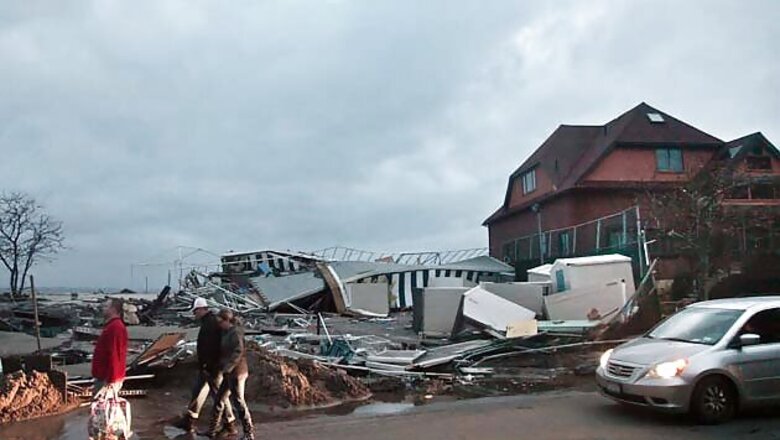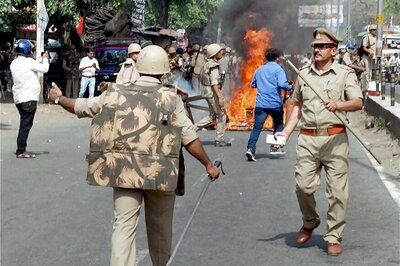
views
New York: Faced with the prospect of days without power and swaths of the city plunged into darkness at night, police brought in banks of lights and boosted patrols to reassure victims of a monster storm that they won't be victims of crime. Some prominent galleries in Manhattan's Chelsea neighborhood hired private security and apartment building superintendents suddenly became guards. In Coney Island, about 100 police officers stood on corners or cruised in cars to guard a strip of vandalised stores and a damaged bank, to the relief of shaken residents.
"We're feeling OK, but at first we felt worried," 12-year-old Oleg Kharitmov said Tuesday as he walked his dog with his parents by the bank. "I'm pretty happy that the cops are here." The precautions came on a second powerless night after the city was battered by Hurricane Sandy on Monday night and residents grappled with how long it would take to get back to normal - or at least New York's version of normal.
"Clearly, the challenges our city faces in the coming days are enormous," Mayor Michael Bloomberg said as officials warned that power might not be back until the weekend for hundreds of thousands of people accustomed to a life carried by subway, lit by skyline and powered by 24-hour deli. While some bus service resumed and some bridges reopened at midday, transit officials said they couldn't predict when the subway would run again after suffering the worst damage in its 108-year history.
The storm's deadly impact grew grimly clearer as the worst of it moved off: The death toll rose to 18 in the city, including two people who drowned in a home and one who was in bed when a tree fell on an apartment. A fire destroyed as many as 100 houses in a flooded beachfront neighborhood in Queens, while firefighters used boats to rescue people in chest-high water. Faye Schwartz surveyed the damage in her Brooklyn neighborhood, where cars were strewn like leaves, planters were deposited in intersections and green trash bins were tossed on their sides.
"Oh, Jesus. Oh, no," she said. There was no sign of looting or widespread crime, although about a dozen people were arrested in Coney Island and Queens on charges of trying to steal from shops, a pharmacy and the bank, where the entire front was missing. As night fell, nerves frayed.
Yvique Bastien waited outside an apartment complex with her two sons, her daughter, 4-month old grandchild and a pushcart full of supplies, hoping to get a ride to a relative's home from a member of her church. With the power out, it wasn't safe to stay, she said. "We don't know what can happen to us," she said.
In Chelsea, residents strolled down darkening streets with no lights, while traffic police tried to manage major intersections. Roberto Pineta stood in front of the apartment building where he works as superintendent, saying he took it upon himself to keep residents safe by sitting in a chair inside the front entrance, day and night, sleeping only a few hours at a time. Candles lit the entrance to a nearby apartment building where another superintendent and his staff were putting in extra hours while power is out.
"It's a little disconcerting to be in the dark, but I feel safe - these guys are great," Stacey Vuolo said as she headed to her brother-in-law's nearby apartment, which at least had cold water for a shower. On West 24th Street, generators lit up the Andrea Rosen gallery, which had hired private security.
Down the street, artist Arlene Rush said she didn't require extra security in her third-floor studio, because it required several keys to access from the street. "I don't really need the cops," added neighbor Guy Kloppenburg, a teacher. "We knock on each other's door to make sure everyone is OK."
Bloomberg promised "a very heavy police presence" in the darkened neighborhoods, which include much of Manhattan south of the Empire State Building, from the East River to the Hudson River. Even outside the blackout areas, police deployed vans and patrol cars with their roof lights on, along with officers on the streets in a robust show of force. For the 8 million people who live here, the city was a different place one day after being battered by the megastorm - a combination of Hurricane Sandy, a wintry storm and a blast of arctic air.
Schools were shut for a second day and were closed Wednesday, too. The New York Stock Exchange was closed for a second day, the first time that has happened because of weather since the 19th century, but planned to reopen Wednesday, with Bloomberg ringing the opening bell. Problems to high-voltage systems caused by the storm forced the utility to cut power Tuesday night to about 160,000 additional customers in Brooklyn and Staten Island.
Consolidated Edison, the power company, estimated it would be four days before the last of the 323,000 customers in Manhattan and Brooklyn who lost power have electricity again. For the Bronx, Queens, Staten Island and Westchester County, with more than 450,000 outages, it could take a week. The city modified its taxi rules and encouraged drivers to pick up more than one passenger at a time, putting New Yorkers in the otherwise unthinkable position of having to share a ride with a stranger.
At a small market called Hudson Gourmet, in Manhattan's Greenwich Village, cashiers made change by candlelight and shoppers used flashlights to scour the shelves. Lee Leshen used the light from his phone to make his selections - three boxes of linguine and a can of tomatoes. His power was out, but the gas in his stove worked, so he could cook. He said he almost never cooks but is learning.


















Comments
0 comment